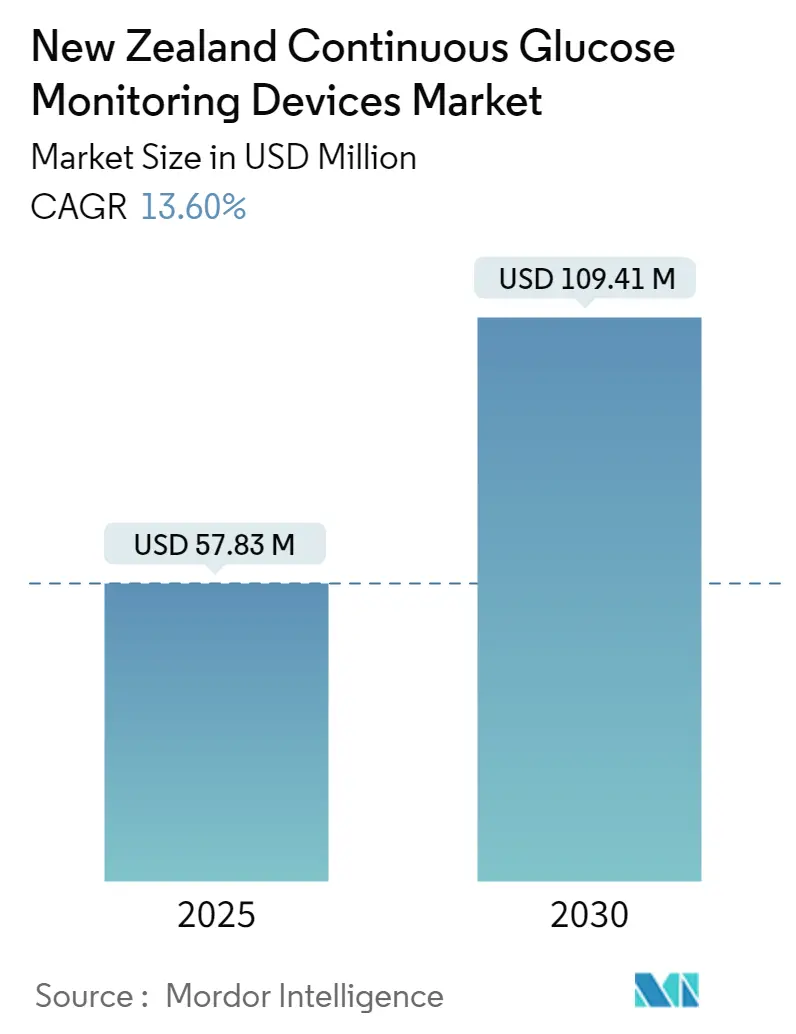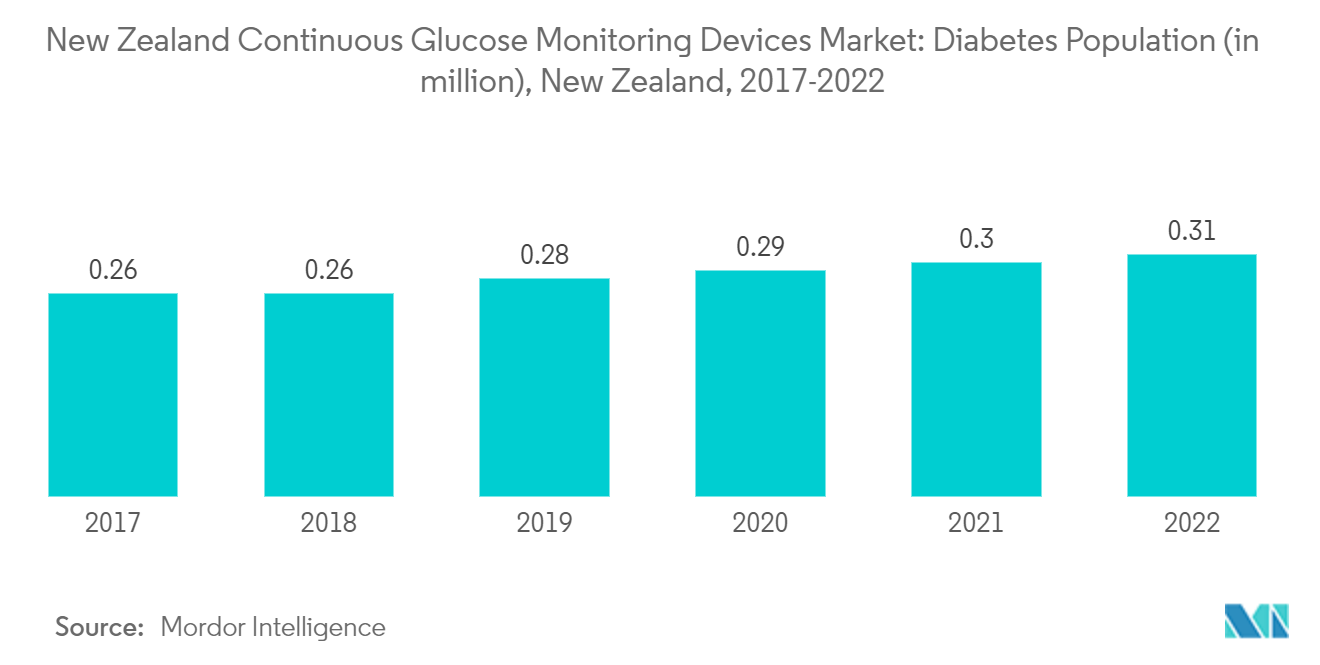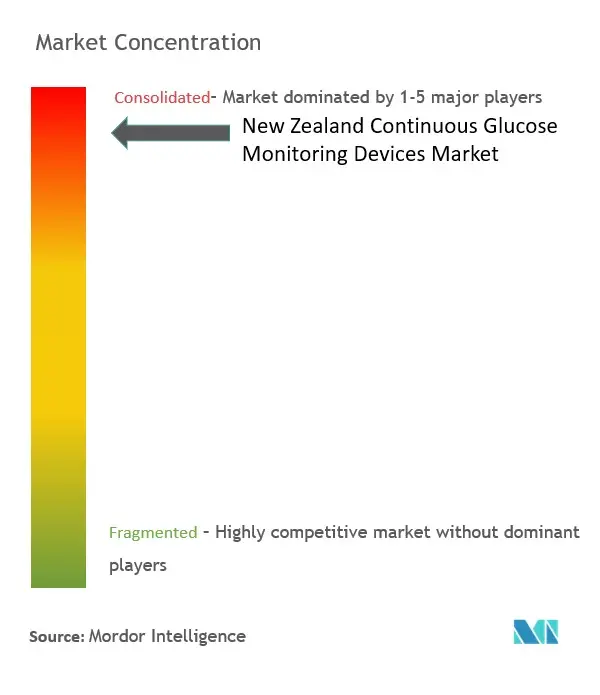
New Zealand Continuous Glucose Monitoring Devices Market Analysis
The New Zealand Continuous Glucose Monitoring Devices Market size is estimated at USD 57.83 million in 2025, and is expected to reach USD 109.41 million by 2030, at a CAGR of 13.6% during the forecast period (2025-2030).
The COVID-19 pandemic highlighted that substantially greater attention had to be given to diabetes to avoid unnecessary and inequitable outcomes from the infection. All necessary steps were taken and maintained to protect this high-risk group through nationwide public health measures to prevent transmission, ensuring vaccination has been given and undertaking workplace risk assessments. Notably, the rates of diabetes are higher among Maori, Pacific, and South Asians compared with New Zealand Europeans, particularly those living in deprived situations. These groups were especially vulnerable to the far-reaching impacts of the COVID-19 crisis, as they were disproportionately exposed to risk, potentially exacerbated by the sudden loss of jobs and income and reduced access to usual social support and healthcare.
Mediray (Distributor Company for Freestyle Libre Products) was classed as an essential service and continued to provide FreeStyle Libre systems as usual. The Mediray technical support line remained open for call-in and pick-up options. Such factors impacted market growth positively during the pandemic.
In 2021, the Ministry of Health Virtual Diabetes Register estimated that more than 290,000 people were living with diabetes. The Pacific population had the highest estimated rate of diabetes, followed by the Indian population and the Māori population in New Zealand. The European or other populations had the lowest estimated rate of diabetes. Blood glucose level testing is a crucial technology for Diabetes because it facilitates knowledge of how different foods, medications, and activities affect a patient's diabetes and how much insulin is needed, and when for effective diabetes management. Generally, glucose testing was done with finger-pricking kits that measure levels via small blood samples. Currently, automated glucose monitoring systems are being used.
Continuous Glucose Monitoring Devices are automated glucose monitoring systems that consist of a small device worn on the body (typically the abdomen or arm) and held on by an adhesive patch. The sensor part of the device has a cannula that is inserted into the top layer of skin and uses samples of interstitial fluid to check glucose levels. Sensors are connected to a transmitter that can send data wirelessly to a dedicated mobile receiving device or smartphone. The usage of CGMs for people with Diabetes and their caregivers and communities is beneficial for managing their blood glucose and insulin levels to maintain their health outcomes.
CGM makes it significantly easier to manage blood glucose levels by decreasing interruptions, allowing for better sleep and improving the mental health of patients or caregivers by reducing the overall mental load of managing diabetes, thereby enhancing the market prospects in the years to come.
New Zealand Continuous Glucose Monitoring Devices Market Trends
Increasing diabetes prevalence
Diabetes prevalence in New Zealand is projected to see significant growth during the forecast period, with approximately 360,000 people by 2028. There is a double burden because rates are higher and outcomes worse among Māori and Pasifika, and they typically face more significant socio-economic hardship. Type 1 diabetes is strongly linked to a family history of the condition, but the exact cause is unknown. No modifiable factors increase the risk for type 1 diabetes, although maintaining a healthy lifestyle is essential for managing the symptoms and long-term complications associated with the condition.
People are at a higher risk of getting type 2 diabetes. Major biomedical risk factors for type 2 diabetes are impaired fasting glucose and impaired glucose tolerance, high blood pressure, dyslipidemia, overweight and abdominal obesity, and behavioral risk factors, including unhealthy diets, insufficient physical activity, and smoking.
According to the New Zealand Health Survey by the Ministry of Health, the prevalence of obesity in New Zealand adults was around 34% in 2021-2022. There are many complications developed because of diabetes, including stroke, kidney disease, nerve damage, hearing loss, hypertension, eye complications, foot complications, skin complications, etc. Therefore, there is a need to monitor the blood glucose levels of patients with diabetes constantly. Lowering blood sugar is the first step in the treatment of diabetes, as patients who have diabetes need to be monitored so that their blood glucose levels do not go beyond the expected value. Using CGMs for people with Diabetes and their caregivers and communities is beneficial for managing their blood glucose and insulin levels to maintain their health outcomes.
CGM makes it significantly easier to control blood glucose levels by decreasing interruptions, allowing for better sleep, and improving the mental health of patients or caregivers by reducing the overall cognitive load of managing Diabetes. CGMs are widely used in children with Type-1, enabling parents to feel safer, allowing other adults to care for their child, giving children more freedom and autonomy in their day-to-day lives, and enabling access to more normal experiences and opportunities.
The rising prevalence of diabetes and growing awareness regarding diabetic care further drives the market for Continuous glucose monitoring devices in New Zealand.

The sensors segment held the highest market share in the current year
The sensors segment held the highest market share of about 80% in the current year.
To use a CGM, a small sensor is inserted into the abdomen (or arm) with a tiny plastic tube known as a cannula penetrating the top layer of skin. An adhesive patch holds the sensor in place, allowing it to take glucose readings in interstitial fluid (the fluid that surrounds cells in the body) day and night. Generally, the sensors must be replaced every 7 to 14 days. A small, reusable transmitter connected to the sensor allows the system to send real-time readings wirelessly to a monitor device that displays blood glucose data. Some systems have a dedicated monitor, and some display the information via a smartphone app.
Depending on the manufacturer, a CGM sensor can be used continuously for several days or weeks. Three glucose monitoring systems are currently available for private purchase in New Zealand: the Freestyle Libre (a flash monitoring system that requires manual checking rather than automatic data transmission), the Medtronic, and the Dexcom. Each system includes disposable/consumable sensors that must be changed approximately every ten days. Some of these can be purchased as part of a 12-month payment plan and on an individual purchase basis.
In January 2023, Abbott's cutting-edge diabetes technology was approved in New Zealand, costing the same as the original FreeStyle Libre Glucose Monitoring device. To allow users to sleep through the night and be awakened only when necessary, this gadget has optional and programmable alarms that notify them of essential glucose levels. The new product launches in New Zealand are further expected to affect the market positively over the forecast period.

New Zealand Continuous Glucose Monitoring Devices Industry Overview
The New Zealand Continuous Glucose Monitoring Devices Market is highly consolidated, with few significant players. Manufacturers like Abbott, Dexcom, and Medtronic have a global market presence and occupy a major share. There have been constant innovations driven by these manufacturers while also adhering to organic growth strategies, which is evident from the R&D spending of these companies.
New Zealand Continuous Glucose Monitoring Devices Market Leaders
-
Abbott Diabetes Care
-
Dexcom, Inc.
-
Eversense
-
Medtronic PLC
-
AiDEX
- *Disclaimer: Major Players sorted in no particular order

New Zealand Continuous Glucose Monitoring Devices Market News
- October 2022: Dexcom, Inc. and its New Zealand subsidiary, New Zealand Medical and Scientific Ltd Diabetes, announced that the Dexcom G7 Continuous Glucose Monitoring System was now available in New Zealand for people with diabetes aged two years and older.
- January 2023: The next-generation Continuous Glucose Monitoring System FreeStyle Libre 2 is available to New Zealanders with insulin-requiring diabetes. The device features optional and customizable alarms to alert users of critical glucose levels, allowing them to sleep through the night and be woken up only when necessary. New Zealanders living with diabetes can now choose to be alerted of critical glucose levels instantly.
New Zealand Continuous Glucose Monitoring Devices Industry Segmentation
CGM, as a wearable sensor, automatically detects and measures blood glucose levels around the clock. Data is then sent from the sensor to a receiver or smart device using a transmitter that is placed above the skin. Patients receive alerts from the transmitter or monitor their current glucose level and trends wirelessly, and it notifies patients when it’s time to replace the sensor. The New Zealand Continuous Glucose Monitoring Devices Market is segmented into Components (Sensors and Durables) and by Provinces. The report offers the value (in USD) and volume (in Units) for the above segments.
| By Component | Sensors |
| Durables (Receivers and Transmitters) | |
| By Provinces (Quantitative Analysis) | Auckland |
| New Plymouth | |
| Wellington | |
| Nelson | |
| Other Provinces |
New Zealand Continuous Glucose Monitoring DevicesMarket Research FAQs
How big is the New Zealand Continuous Glucose Monitoring Devices Market?
The New Zealand Continuous Glucose Monitoring Devices Market size is expected to reach USD 57.83 million in 2025 and grow at a CAGR of 13.60% to reach USD 109.41 million by 2030.
What is the current New Zealand Continuous Glucose Monitoring Devices Market size?
In 2025, the New Zealand Continuous Glucose Monitoring Devices Market size is expected to reach USD 57.83 million.
Who are the key players in New Zealand Continuous Glucose Monitoring Devices Market?
Abbott Diabetes Care, Dexcom, Inc., Eversense, Medtronic PLC and AiDEX are the major companies operating in the New Zealand Continuous Glucose Monitoring Devices Market.
What years does this New Zealand Continuous Glucose Monitoring Devices Market cover, and what was the market size in 2024?
In 2024, the New Zealand Continuous Glucose Monitoring Devices Market size was estimated at USD 49.97 million. The report covers the New Zealand Continuous Glucose Monitoring Devices Market historical market size for years: 2019, 2020, 2021, 2022, 2023 and 2024. The report also forecasts the New Zealand Continuous Glucose Monitoring Devices Market size for years: 2025, 2026, 2027, 2028, 2029 and 2030.
Our Best Selling Reports
New Zealand Continuous Glucose Monitoring DevicesIndustry Report
Statistics for the 2025 New Zealand Continuous Glucose Monitoring Devices market share, size and revenue growth rate, created by Mordor Intelligence™ Industry Reports. New Zealand Continuous Glucose Monitoring Devices analysis includes a market forecast outlook for 2025 to 2030 and historical overview. Get a sample of this industry analysis as a free report PDF download.



